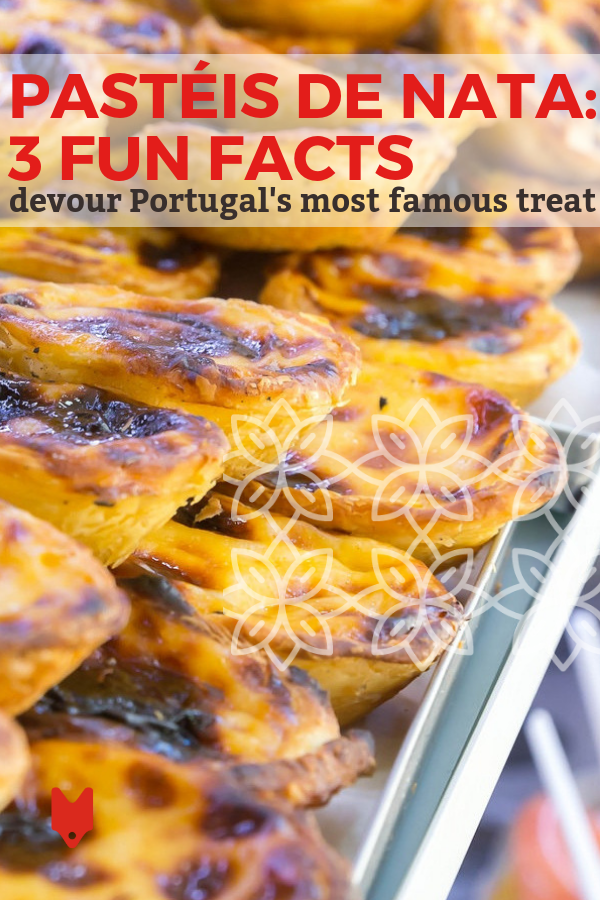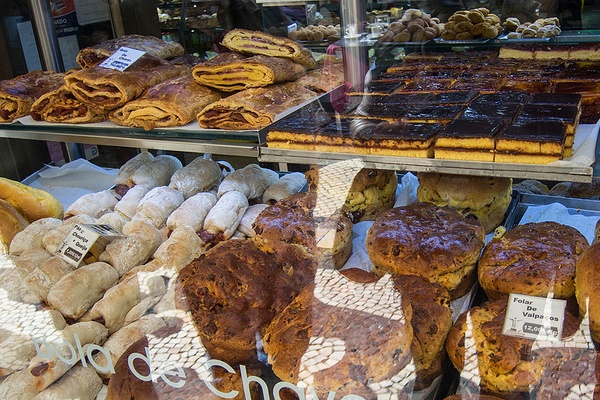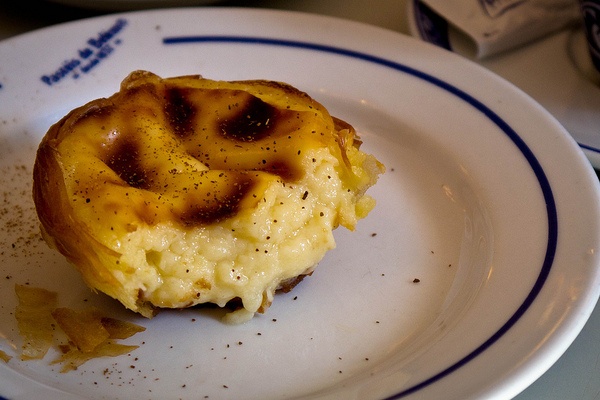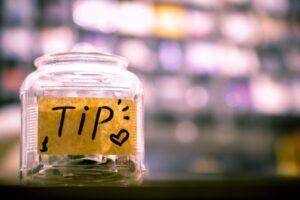Last Updated on December 5, 2025 by Emma Fajcz | Published: December 20, 2018
This post is part of our Behind the Bite series, deep dives into the dishes that we can’t stop thinking about.
If you really want to get under the skin of Lisbon, head to a pastelaria.
In every neighborhood of the city, old ladies brush shoulders with hipsters, inspecting the mind-boggling array of pastries laid out behind glass.
Taking a few minutes out of your day to sit down, pause, and enjoy a coffee and a pastry is a central part of the city’s culture. And the kings of the pastries are the pastéis de nata. Egg custard inside a flaky pastry crust, with a mottled browned surface, nothing could be more Lisbon.

Photo Credit: Marco Verch, Text Overlay: Devour Lisbon Food Tours
A Pastry Born in a Monastery
You might also hear pastéis de nata referred to as pastéis de Belém. To understand why, we need to take a trip back in time.
From some time in the middle of the 18th century, monks in the Jerónimos Monastery, located in Belém, along the seafront from the city center, would use up leftover egg yolks to make these sweet treats. After Portugal’s Liberal Revolution in 1820, and the subsequent closure of the monasteries, the monks were forced to find new ways to get by.
Thinking on their feet, they started selling their beloved custard tarts from a storefront round the corner. Eventually, they sold their secret recipe to a local family, who continue selling the original pastéis de Belém from their eponymous cafeteria.
For many, this is still the place in the city to taste the treats, but pastry shops around the city now make their own versions.

So what makes the perfect pastel de nata? Really, there’s not much to it: this is all about achieving perfection through simplicity. The pastry should be flaky and buttery, cracking to the bite but maintaining its form till the last bite. The egg custard, a perfect balance of smooth and firm, with its browning just on the point of being burnt. Finally, an optional dusting of sugar or cinnamon adds the finishing touch.
Do it yourself: Make pastéis de nata at home with our Portuguese custard tarts recipe.
Making Time for Pastéis De Nata
To understand the significance of the pastel de nata is to understand a little more about Lisbon life. It’s not something to eat on the go, or to slave hours over in the kitchen.
Contemporary dancer, Lisbon local, and custard tart aficionado David Marques explains: “It’s not family baking. For me, it’s a cake from the street, from the neighborhood café. The perfect accompaniment to a quick coffee at the bar, or the best cake to have at home: everyone likes them.”
Whether stopping for a few minutes during a hectic day at the local pastry shop or taking a box round for coffee and catching up with an old friend, pastéis de nata are all about a little bit of indulgence in everyday life.

Photo Credit: Theo K
That’s why there are few better ways to start an argument with lisboetas than to ask which pastelaria makes the best ones. Perhaps surprisingly, the revolution in Portuguese cooking over the past few years seems to have left the pastel de nata largely untouched. Some newer establishments have put their own twist on things: Manteigaria Lisboa offer a pastel de nata com bacalhau, adding salt cod to combine two Lisbon classics in one.
But by and large, instead of competing over ever more fanciful creations, pastry chefs fight to execute the classic recipe flawlessly. According to Marques, that’s because it forms part of the fabric of the city: “For the Portuguese, it’s almost like bread: something that you don’t question, because it’s always been there. It’s the most discreet and reliable cake, not something to be made into an icon.”
In Search of the Perfect Tart
In a sense, this simplifies the debate about the best pastel de nata in the city. The best one is in the pastry shop on your corner, where you know the barman, and where you meet with your friends on a lazy Saturday morning to put the world to rights. That said, part of the joy of exploring Lisbon is finding your own personal favorite.
Are you coming to Lisbon? Don’t waste a single meal—check out our ultimate foodie guide to where to eat in Lisbon!
There are a few you shouldn’t miss, of course. Pastelaria Aloma in Campo do Ourique have been in business since 1943, winning many awards for their tarts. Fabrica da Nata, meanwhile, offer a fantastic-value custard tart and port wine pairing. But if you really want to understand the meaning of the pastel de nata, head out on your own.
While exploring the city, pop into local pastry shops for a break. Order a coffee, survey the offering, point to the tart you want (with the perfect browned-burnt balance!), and find your own favorite. Then, you’ll truly be living Lisbon like a local.

Get to know the story behind more of your favorite Portuguese bites on our Tastes & Traditions of Lisbon Food Tour. You’ll try the most iconic foods in Lisbon and you’ll leave with a deeper connection to the city’s food culture—and the people who are a part of it.









Please could you give me the recipe which you mix all the ingredients together and bake NOT the one you need puff pastry for the recipe i want creates it’s own pastry casings I had the recipe but sadly have misplaced it please help me
Hi Jackie,
Here’s a recipe that uses a homemade crust rather than puff pastry: https://www.foodrepublic.com/recipes/pasteis-de-nata/
We hope this helps—happy baking!